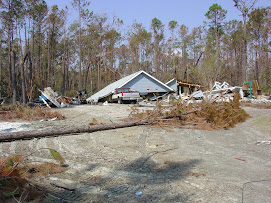In our first post on the trial, testimony revealed Rimkus Engineering supervisor James Jordan altered the onsite engineer's report on the Aiken site favorably towards Rimkus client USAA without consulting the onsite engineer, Roverta Chapa in direct violation of Rimkus procedure. The following Sun Herald story recounts the testiomony of two plaintiff experts, a metorologist and structural engineer who both introduced evidence supporting the conclusions of Rimkus onsite engineer Roverta Chapa who also found strong evidence of wind damage to the property:
Experts assert pre-surge tornado damage
Testimony in trial against insurer USAA
By PAM FIRMINmailto:FIRMINpfirmin@sunherald.com
GULFPORT --Testifying as expert witnesses, a meteorologist and a forensic engineer Wednesday afternoon described why tornadic force rather than storm surge was most likely responsible for the Katrina destruction of David and Marilyn Aiken's home in Henderson Point.
A lawsuit filed by the Aikens seeks damages and full payment of their $680,000 insurance policy with USAA Casualty Insurance Co., which paid them $178,000 in structural and contents damage. The suit claims USAA and Rimkus Consulting Group Inc., which was employed by USAA, conspired to to defraud them. Earlier testimony revolved around whether changes to a property report by structural engineer James W. Jordan were made to downplay wind damage so USAA would owe less money.
On Wednesday, Day 3 of the trial projected to last several weeks, presiding U.S. District Judge L.T. Senter Jr. frequently tried to move proceedings along, one time telling attorneys who haggled over details of intricate meteorological documents that it was "not necessary to go over every bit of the document" and later that "everybody's tired of hearing his jabbering back and forth."
Documents were provided by meteorologist Charles Barrere of Norman, Oka., formerly of the New Orleans area, who said they showed a tornado being tracked by the National Weather Service in New Orleans around 3 a.m. Aug. 29 most likely passed directly over the Aikens' house hours before the waters rose. The eight jurors were able to look at these on monitors in front of their seats.
Dr. Charles Ivy, a forensic engineer from Florida, said it was significant that 90 percent of the nails on surviving beams at the Aiken property were bent in a direction from north to south and that four sturdy frames still standing were "whipped toward the west, leaning toward the direction the water came from. If water caused the destruction, they would have been leaning toward the east."
Court begins today with cross examination of Ivy by USAA attorney Greg Copeland and Rimkus attorney David Ward.
Thursday, January 17, 2008
Aiken V USAA Casualty Insurance Company Day 3: The Experts
Posted by
Sop811
at
6:40 AM
![]()
![]()
Labels: Insurance, Insurance Law, Sop, USAA
Subscribe to:
Post Comments (Atom)

No comments:
Post a Comment